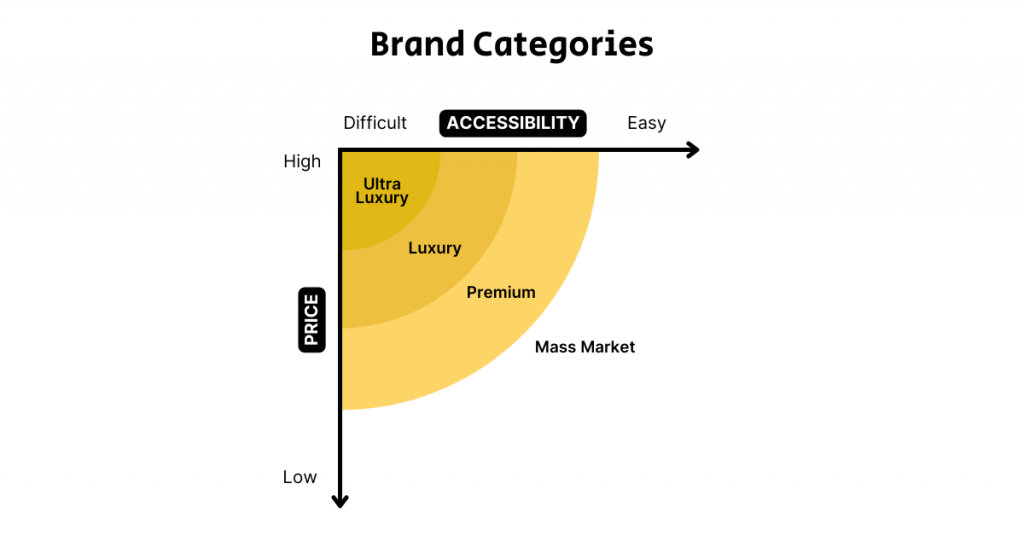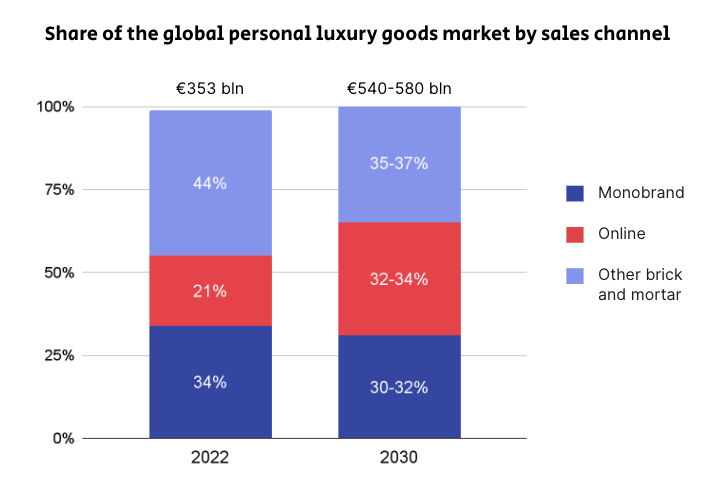In the world of luxury marketing, maintaining a strong and distinctive brand identity is crucial for capturing the attention and loyalty of customers. As luxury eCommerce continues to grow in popularity, brands must also prioritize exceptional user experience (UX) to provide a seamless and personalized shopping experience online. And in today’s rapidly evolving marketplace, luxury brands may need to consider a redesign to remain relevant and differentiate themselves from competitors.
A luxury brand redesign requires a delicate balance of preserving the brand’s heritage and values while embracing modern aesthetics, digital technologies, and intuitive UX design. In this blog post, we will discuss the key principles of a luxury brand redesign, including a focus on exceptional craftsmanship, personalized services, and unique selling points, as well as how brands can provide a superior UX to meet the expectations of luxury shoppers online. We will also address the stage where luxury shoppers spend the most time in, and how brands can overcome the challenges of this phase to capture customer attention and loyalty. Let’s explore the realm of luxury brand redesign and discover how brands can thrive in the rapidly evolving luxury eCommerce industry in 2023.
Current state of luxury retail
In 2022, Bain & Company estimated that the Luxury market reached €1.38 trillion, growing 19% – 21%. In addition, 95% of luxury brands enjoyed a positive compound annual growth rate in 2022.
However, given the looming recession, 53% of consumers plan to reduce their spending on luxury/premium products, according to a recent PwC survey. The personal luxury goods segment is expecting a slow 3 – 5% growth in the base case and 6% – 8% in a positive scenario in 2023. Then again, the Luxury market will be more resilient to recession than in 2009.
Luxury brands differentiation

Nielsen Norman Group classifies brands/products into the following 4 categories: mass market, premium, luxury, and ultra luxury.
- Mass market products or services are made in large quantities and are accessible to many consumers at reasonable prices.
- Premium products are priced higher than mass market, but they offer better quality or design. Manufacturers of premium products try to meet demand by increasing supply.
- Luxury brands are characterized by high-quality products or services offered at prices so high that they are out of reach for many consumers. These prices are partly justified by the high quality of the products, but more so by the emotional connection that customers have with the brand. Luxury brands often have devoted customers, and their products may serve as status symbols. While luxury brands intentionally limit supply to keep demand high, they are still accessible to people who can afford them.
- Ultra luxury brands set prices beyond most people’s reach. However, money alone is not enough to gain access to these products or services. VIP customers or celebrities who have established relationships with the brand may be the only ones granted access to them. The goal of ultra luxury brands is to be extremely exclusive.
Top luxury brands
According to Luxe Digital, these are the luxury brands that had the best online presence in 2022.

Key principles in luxury brand redesign
1. Exclusivity and rarity
Luxury brands can employ the exclusivity and rarity strategy by using their online presence to enhance bLuxury brands can employ the exclusivity and rarity strategy by using their online presence to enhance brand visibility and create an emotional connection with customers rather than as a mere sales channel. Websites are often used to showcase only a select few product lines while providing in-depth information about all available offline and online products.
2. Price matters
Brands that cannot or choose not to display specific prices online should consider providing a price Brands that cannot or choose not to display specific prices online should consider providing a price range if possible. While some of the richest individuals may not have budget limitations, this is not true for all wealthy individuals. Even those without budget constraints often have a rough idea of the price range they are willing to spend based on their motivation and reason for buying a product..
3. User-friendly visual design
Luxury shoppers expect a premium experience regardless of the channel of engagement. That’s why Luxury shoppers expect a premium experience regardless of the channel of engagement. That’s why brands should really focus on balanced visual branding and readability while keeping content easy to scan and understand.

4. Brand’s story
The longest phase in a luxury shopper’s buying journey is the Consideration stage. During this phase, shoppers spend considerable time researching products and deciding which luxury item to purchase. Studies have shown that luxury shoppers often spend a lot of time researching a company’s history before making a purchase. To build an emotional connection with customers, luxury brands must create a compelling narrative that represents their values and brand history on their websites.
5. Extra services
Although few luxury brands currently offer special services and benefits through their digital products, brands should strongly consider this approach. Rather than a one-time experience, luxury brands could create a community or offer additional experiences and customer care online, such as providing advice and tips for caring for specific products, initiating and tracking repair or cleaning services, and sending notifications about upcoming invite-only events.
6. Virtual personalized recommendations
Product recommendations and styling advice are powerful tools that luxury brands can use to enhance the online shopping experience for their customers. Through digital showrooms and live sessions with sales representatives, luxury brands can provide tailored recommendations and advice, enhancing customer satisfaction and gaining a competitive edge online.

Addressing the challenges in the Consideration stage
Luxury shoppers spend the most time in the Consideration stage, which poses numerous challenges, including:
- Poor organization and information architecture
- Insufficient product photos
- Confusing product names, attributes, and terminology
- Missing product details
- Inaccurate or irrelevant product recommendations
- Sloppy UX design and bugs
To overcome the challenges of the Consideration stage, luxury brands should prioritize the following:
1. Ensure excellent organization and information architecture
- Implement intuitive navigation to help customers find what they need quickly and easily
- Organize products into logical categories and subcategories
- Utilize filters to refine product searches
2. Provide ample photos of the product
- Use high-quality images that showcase the product from multiple angles
- Incorporate zoom features to enable customers to examine products more closely
- Consider using 360-degree product views to provide a more immersive experience
3. Simplify product names, attributes, and terminology
- Use clear and concise language that is easy to understand
- Avoid technical jargon or industry-specific terms that customers may not be familiar with
- Provide definitions or explanations for any unfamiliar terms or product attributes
4. Offer detailed product descriptions
- Provide accurate and detailed descriptions of each product, including materials, dimensions, and care instructions
- Highlight the craftsmanship and quality in product details
- Showcase unique features and benefits of each product to differentiate them from others
- Incorporate customer reviews to provide social proof and enhance trust
5. Provide accurate and relevant product recommendations
- Use customer data and purchase history to provide personalized recommendations
- Implement recommendation algorithms that suggest complementary or related products
- Ensure that recommendations are accurate and relevant to the customer’s needs and preferences
6. Create a seamless UX design and ensure there are no bugs
- Ensure that the website or app is user-friendly and easy to navigate
- Conduct usability testing to identify and address any bugs or glitches
- Continuously monitor and improve the user experience to enhance customer satisfaction
Examples of luxury brands landing pages
Rolex

The Rolex Category page boasts a simple yet sophisticated layout, showcasing:
- A comprehensive overview of the collection
- A premium shopping experience for luxury customers
- Distinctive features and qualities of each product
Greenwich

The Greenwich landing page is brief and concise, featuring:
- Emphasis on the product’s exceptional craftsmanship
- Trust building through customer testimonials and third-party reviews
- Immediate communication of the brand’s core values and mission
Cartier

The Cartier landing page is brief and to the point, featuring:
- Emphasis on exceptional craftsmanship, attention to detail, and style
- Personalized services that are integral to the luxury experience
- The brand’s unique selling points and distinctive qualities
What is the future of luxury retail?
By 2030, we expect luxury retail to take the following direction:
- Mainland China will surpass the Americas and Europe and become the largest luxury market in the world, accounting for 25% – 27% of global luxury purchases.
- Younger generations, including Generations Y, Z, and Alpha—the online-focused generations—are expected to become the largest buyers group of luxury products, making up 80% of luxury purchases.
- Online channel is predicted to become the leading way people buy luxury goods, with an estimated market share of 32% – 34%. Monobrand stores will also gain more ground, reaching a third of the market.


As luxury eCommerce continues to grow, brands must prioritize providing a seamless and personalized user experience (UX) to capture the attention and loyalty of luxury shoppers. In 2023, personalized experiences and exceptional craftsmanship will be key principles in the luxury brand redesign.
Overcoming the challenges of the Consideration stage is also critical to capturing customer attention and loyalty, which requires intuitive design, detailed product information, and tailored recommendations. By embracing digital technologies and prioritizing UX, luxury brands can provide a competitive edge and superior customer experience. In an ever-evolving luxury industry, it is crucial for brands to remain agile and customer-centric to thrive in the marketplace.
Are you looking to redesign your luxury eCommerce store to provide a seamless and personalized shopping experience for your customers? Our experienced Growth team is well-versed in UX design, CRO, and strategic planning, and is eager to help you achieve your goals. Contact us at [email protected] to set up a free consultation and discover how our expertise can take your luxury eCommerce store to new heights.



Share on: